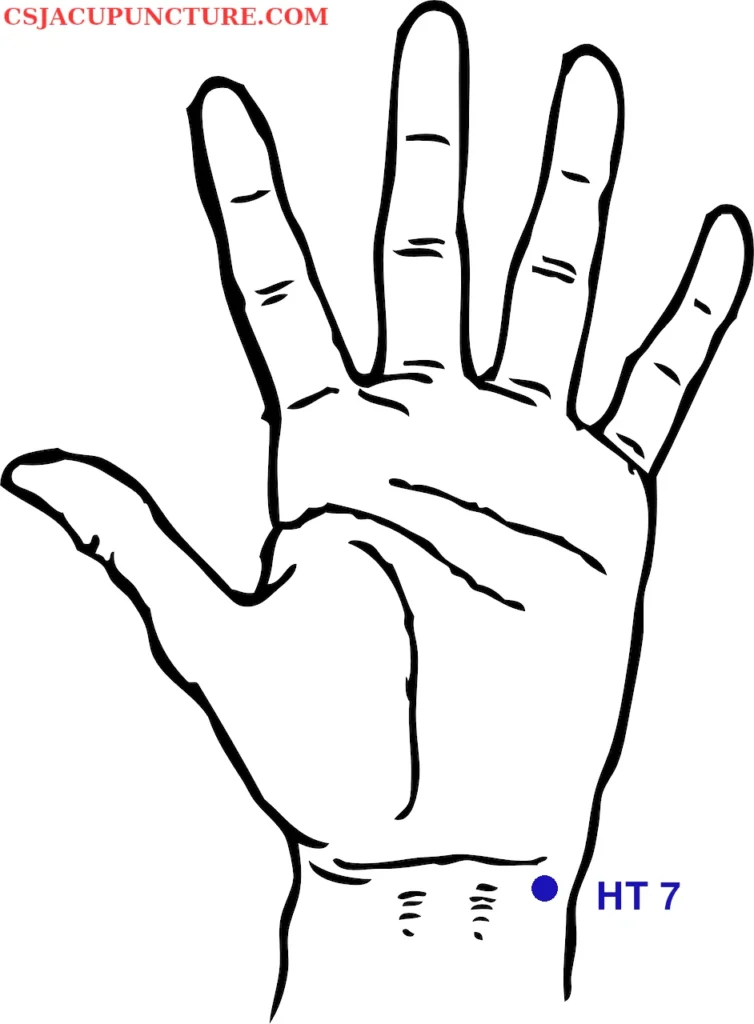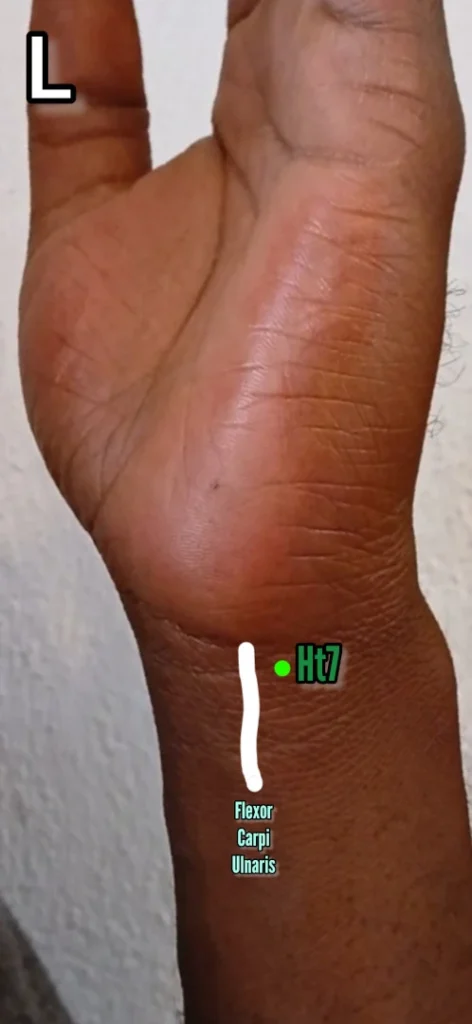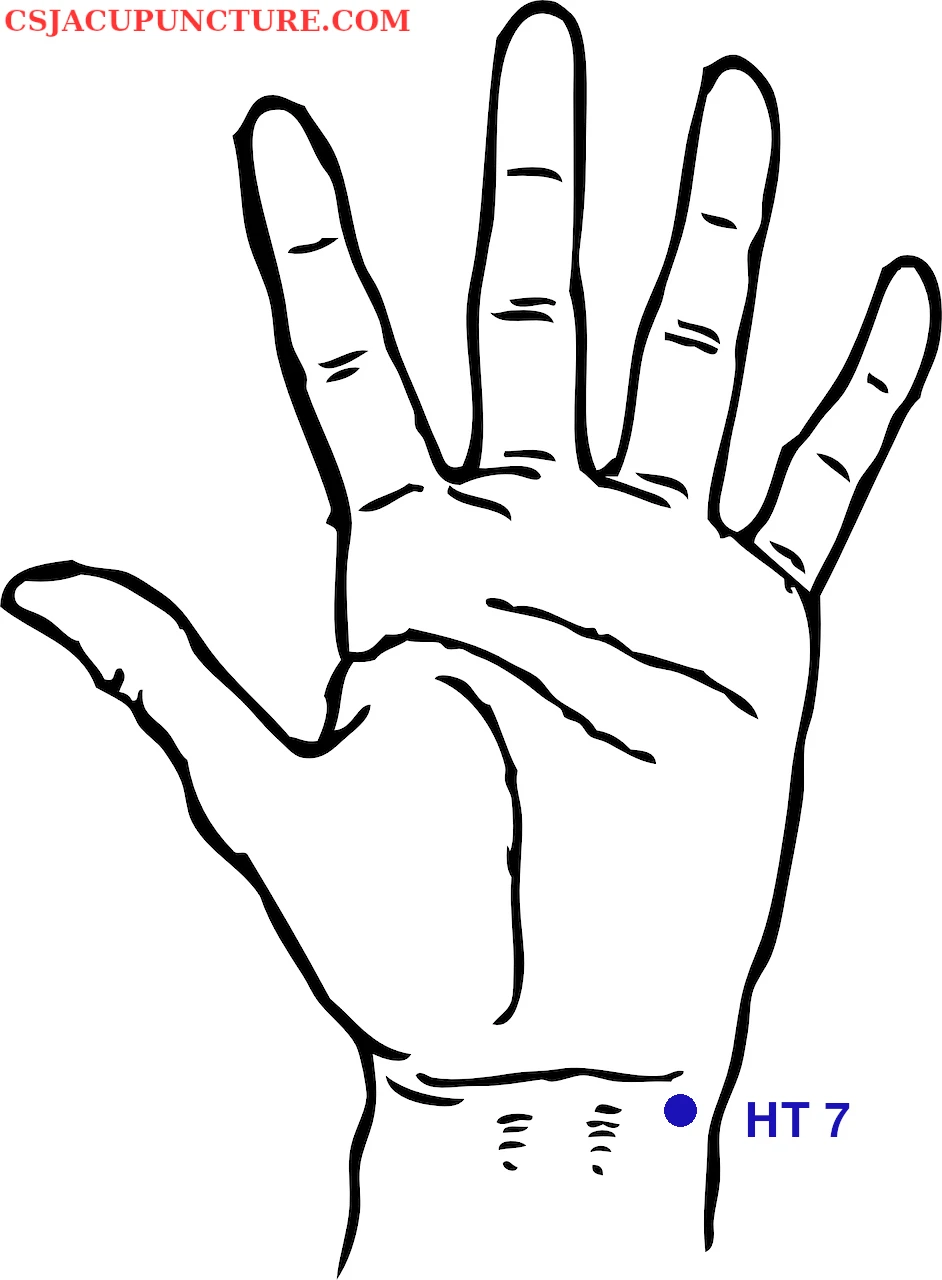This post may contain affiliate links and ads in which we may earn a small percentage of purchases.
Table of Contents
Today, we’re looking into a particularly special acupuncture point: Heart 7, also known as Shenmen or “Spirit Gate”, or “Mind door”. While we will touch on Heart 6 (Yinxi) and Heart 5 (Tongli) in future articles, today’s focus will be entirely on Heart 7 due to its significance in Traditional Chinese Medicine (TCM).

If you’ve ever quit because meal plans felt overwhelming, this approach keeps it simple. The 21-Day Smoothie Diet gives you daily guidance, a detox reset, and easy recipes—so you can focus on consistency instead of planning. Instant digital access. Start today.
When selecting points, I decide based on the symptoms that the patient presents. The location of Heart 7 is crucial for a couple of reasons. First, it’s important to know where it’s situated. Second, there are different methods to access acupuncture points; it’s not always a straightforward process. This adaptability is key to understanding and effectively utilizing the system.
What is Heart 7?
Heart 7 is a key point in the Heart meridian, playing a crucial role in calming the mind and regulating emotions. Known as the Yuan-Primary point of the Heart channel, it is often used in treatments aimed at addressing issues related to anxiety, insomnia, and emotional disturbances. Other conditions may show benefit include amnesia, stupor, mania, insomnia, palpitations due to fright, irritability, and chest pain1.
In TCM, Heart 7 is not just any point—it’s considered the gatekeeper to mental clarity and emotional balance. Even Giovanni Maciocia regarded this as “most important point on the Heart channel and one of the major points of the body”2 By working with this point, practitioners can help restore harmony to both the mind and spirit, offering a powerful means of managing stress and enhancing overall well-being.
A clear and beginner-friendly guide covering over 400 acupuncture points, ideal for students and learners.
 View Book
View Book
Yuan-Primary points are considered highly influential, akin to a top-tier skill in their ability to address the root of an issue. This concept ties into what is referred to as “Original Qi,” though this is a more complex topic that we can explore further at another time. The potency of Heart 7 stems from its role in accessing and utilizing this deep-rooted energy, making it a powerful tool in TCM practices.
Location of Acupuncture Point Heart 7
First, let’s talk about the location of Heart 7. It is situated on the transverse crease of the wrist. This crease is the line that crosses the inner portion of your wrist, anatomically referred to as the anterior side. The point is located on the radial side of the flexor carpi ulnaris tendon. The flexor carpi ulnaris is a muscle that aids in the flexion and adduction (ulnar deviation) of the wrist and plays a role in pronation, allowing for rotation of the hand.

Acupuncture on Heart 7
When needling Heart 7, clinicians should use smaller needles and adjust their technique accordingly. Typically, a needle size of 0.5 cun is used, but in many cases, a depth of 0.25 cun is sufficient to achieve the desired effect. This point does not require excessive stimulation to be effective.
Given that the location of acupuncture points can vary among individuals, it’s important to adjust the needle placement based on each person’s unique anatomy. Using the twin measurement system can help accurately locate Heart 7 on any patient, ensuring precise and effective treatment.
Alternate Acupuncture Point Location
To perform acupuncture on this point is another story. This is where you encounter different approaches to thinking and application. My clinician, Dr. San Huang, who was an exceptional teacher and the dean of our clinic, taught m classmates and I an alternative method that is still practice today.
Instead of needling directly at the traditionally described location on the radial side of the flexor carpi ulnaris tendon, to come in from the medial and inferior side, rather than the anterior and superior (if you do not have a healthcare background then there this is a mouthful of anatomical landmark terminology. I understand, just run with it and in time and education it will come together). This method provides access to the point while prioritizing safety, which has always been my primary concern in practice.

My practice has always prioritized safety. Heart 7 is located on the wrist crease, with Heart 6 positioned 0.5 cun below it, and Heart 5 about 1 cun below the wrist crease. The needle techniques helps to prevent injury to any arteries or veins in the area, as well as the ulnar nerve.
Also, their functionality may differ slightly. Unfortunately, there aren’t enough studies examining the effects of needling in such close proximity and comparing the results. Additionally, individual responses to treatment vary. However, accuracy and knowledge of anatomical landmarks is essential for optimal practice.
Heart 7 and Acupressure
Heart 7 is also valuable for acupressure, making it accessible for self-care. Acupressure on this point doesn’t require extreme force; when applied correctly, even moderate pressure can be highly effective. The effects can often be felt quickly, demonstrating the potency of this point.
Moxibustion on Heart 7
Moxibustion on Heart 7 is another beneficial practice. Moxibustion involves the application of heat to specific areas (without touching the skin, unless it is applied on top of an acupuncture needled point), which helps to promote circulation and improve overall health. When applied to Heart 7, it can enhance the therapeutic effects of the point, supporting better circulation and well-being.
Functions of Heart 7
Heart 7 serves multiple functions, but it is primarily known for its calming and relaxing effects. Clinically, it has been used to treat insomnia, though it’s not the only point for this purpose, it can play a major role. This leads us into the heart-brain connection—an essential concept in both Traditional Chinese Medicine (TCM) and other systems.
The heart is a vital organ, and its relationship with the mind is significant in TCM. We’ll explore the heart as an organ in more detail in future articles because these concepts are fascinating and interconnected. You can see how they form a web, where one aspect influences another.
To calm the mind, it’s important to understand that in TCM, the mind is said to reside in the heart. The heart is believed to nourish the mind, and this is why blood is so important. When the heart is well-nourished by blood, it, in turn, nourishes the mind, supporting mental clarity and emotional balance.
Heart 7 and insomnia
Heart 7 can be helpful for improving sleep and addressing insomnia, which is a significant issue for many people. However, based on my clinical experience and studies, relying on just this one point is usually not sufficient to resolve insomnia. While Heart 7 can be effective for treating anxiety and other conditions with a few selected points, insomnia often requires a more comprehensive approach.
There are numerous factors influencing sleep, many of which are unique to each individual and may not be visible or controllable during a treatment session. Therefore, while Heart 7 can contribute to improving sleep, it should be part of a broader treatment plan tailored to each patient’s specific needs.
Heart 7 is one of the “Power Points” again I’ve identified through my clinical experience—points that consistently produce noticeable effects. Acupressure on Heart 7, even for a short duration, can be a quick and effective method to achieve similar results to needling.
Research on Heart 7
Research on the use of Heart 7 is mixed, and I believe more studies are needed to pinpoint the biomechanics and ideal uses for this point. Also, to overcome flaws in design, quality, and overall I support high quality studies independent of outcome.
In a 2018 study published in PLOS One, Twenty-five male subjects in a randomized placebo-controlled, two-armed pilot trial. “This study demonstrated that treatment at the acupuncture point Heart 7 did not show any treatment-specific effects on the physiological response in a setting of standardized anxiety when compared to a sham control. However, when compared to reference scores, the increase in the peptides cortisol and amylase was 2-fold, which is less than expected (3 up to 4-fold)”3.
A 2017 systematic review of Ht-7 concluded “limited evidence that acupressure and/or moxa” on this point could “improve symptoms of insomnia with some persistence of effect”.4 The study also concluded that Heart 7 “may also decrease anxiety and improve general feelings of wellbeing of insomnia patients”, but to take results “with caution” due to the limited methodological quality of the included trials, and limited high quality trials available.5 The authors recommendations of more rigorous testing.
Videos on Heart 7
Let’s Keep Learning And Researching
There’s still much to learn about Heart 7. It remains an effective point clinically, with research supporting its benefits. By continuing to explore how this point is used in Traditional Chinese Medicine, alongside ongoing biomedical research, we can deepen our understanding and ultimately enhance its application for the benefit of everyone.
- Son CG. Clinical application of single acupoint (HT7). Integr Med Res. 2019;8(4):227-228. doi:10.1016/j.imr.2019.08.005 ↩︎
- Maciocia G. The Foundations of Chinese Medicine: A Comprehensive Text for Acupuncturists and Herbalists. 2nd ed. Churchill Livingstone; 2005:954. ↩︎
- Fleckenstein J, Krüger P, Ittner KP. Effects of single-point acupuncture (HT7) in the prevention of test anxiety: Results of a RCT. PLoS One. 2018;13(8):e0202659. Published 2018 Aug 30. doi:10.1371/journal.pone.0202659 ↩︎
- Wang Z, Hu X, Su J, Gao X, Xu N, Xing Y, Zhuang L. The efficacy and safety of stimulating a single acu-point Shenmen (HT 7) for managing insomnia: A systematic review of randomized controlled trials. Eur J Integr Med. 2017;15:17-22. doi:10.1016/j.eujim.2017.08.010. ↩︎
- ” ↩︎
Medical Disclaimer: This article is for informational and educational purposes only and is not a substitute for professional medical advice, diagnosis, or treatment. Always consult a qualified healthcare provider with any questions about a medical condition or treatment.





